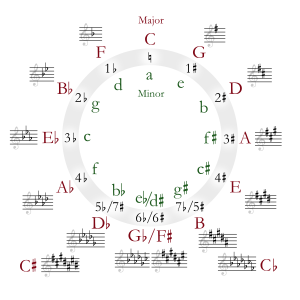| This article needs additional citations for verification. Please help improve this article by adding citations to reliable sources. Unsourced material may be challenged and removed. Find sources: "D-sharp minor" – news · newspapers · books · scholar · JSTOR (May 2018) (Learn how and when to remove this message) |
| Relative key | F-sharp major |
|---|---|
| Parallel key | D-sharp major (theoretical) →enharmonic: E-flat major |
| Dominant key | A-sharp minor |
| Subdominant | G-sharp minor |
| Enharmonic | E-flat minor |
| Component pitches | |
| D♯, E♯, F♯, G♯, A♯, B, C♯ | |
D-sharp minor is a minor scale based on D♯, consisting of the pitches D♯, E♯, F♯, G♯, A♯, B, and C♯. Its key signature has six sharps.
Its relative major is F-sharp major (or enharmonically G-flat major). Its parallel major, D-sharp major, is usually replaced by E-flat major, since D-sharp major's two double-sharps make it impractical to use. Its enharmonic equivalent, E-flat minor, has six flats.
The D-sharp natural minor scale is:
Changes needed for the melodic and harmonic versions of the scale are written in with accidentals as necessary. The D-sharp harmonic minor and melodic minor scales are:
Scale degree chords
The scale degree chords of D-sharp minor are:
- Tonic – D-sharp minor
- Supertonic – E-sharp diminished
- Mediant – F-sharp major
- Subdominant – G-sharp minor
- Dominant – A-sharp minor
- Submediant – B major
- Subtonic – C-sharp major
Music in D-sharp minor
D-sharp minor is infrequently used as the principal key of pieces in the Classical era. More common is notation in E-flat minor, which is a relatively manageable key for many brass instruments and woodwinds. In the 24 canonic keys, most of the composers preferred E-flat minor, while Johann Sebastian Bach, Sergei Lyapunov, and Manuel Ponce preferred D-sharp minor.
From Bach's The Well-Tempered Clavier, the eighth fugue from Book 1 and the eighth prelude and fugue from Book 2 are in D-sharp minor; both fugues end with a Picardy third, requiring an F![]() in the final D-sharp major chord.
in the final D-sharp major chord.
The second of Lyapunov's 12 Transcendental Études ("Ronde des Fantômes") is also in D-sharp minor.
Alexander Scriabin's Etude Op. 8, No. 12 is in this key, perhaps the most famous example.
The second movement from Charles-Valentin Alkan's Grande sonate 'Les quatre âges', subtitled Quasi-Faust, is also in D-sharp minor (but ends in F-sharp major), and modulates into even sharper keys along the way, some even being theoretical keys, such as G-sharp major and D-sharp major.
In a few scores, 6-sharp key signatures in the bass clef are written with the sharp for the A on the top line.
Despite the key rarely being used in orchestral music other than to modulate, it is not entirely uncommon in keyboard music. For orchestration of piano music, some theorists recommend transposing the music to D minor or E minor. If D-sharp minor must absolutely be used, one should take care that B♭ wind instruments be notated in F minor, rather than E-sharp minor (or G instruments used instead, giving a transposed key of G-sharp minor), and B♮ instruments in E minor, in order to avoid double sharps in key signatures. Meanwhile, the E horns would have parts written with a B minor key signature. Instruments in F can be written in A-sharp minor but it is more recommended to use B-flat minor for them.
References
- "Key of D sharp minor, chords". Retrieved 2023-08-17.
- "basicmusictheory.com: D-sharp major scale". www.basicmusictheory.com. Retrieved 2023-08-17.
External links
- [REDACTED] Media related to D-sharp minor at Wikimedia Commons
| Diatonic scales and keys | |||||||||||||||||||||||||||||||||||||||||||||||||||||||||||
|---|---|---|---|---|---|---|---|---|---|---|---|---|---|---|---|---|---|---|---|---|---|---|---|---|---|---|---|---|---|---|---|---|---|---|---|---|---|---|---|---|---|---|---|---|---|---|---|---|---|---|---|---|---|---|---|---|---|---|---|
| |||||||||||||||||||||||||||||||||||||||||||||||||||||||||||




